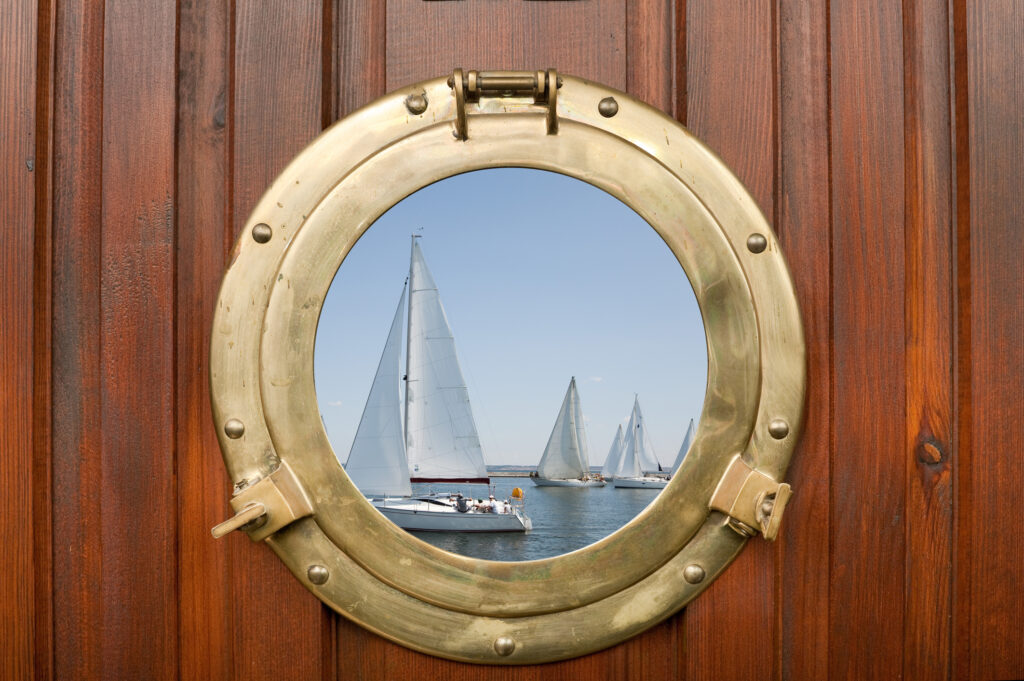
As most of you may know, most windows on boats at least older boats tend to be a round shape. Now they may be more of a rectangle or even square but the old style was round or also known as a porthole.
A round window will cause less stress on the window edges. If the window was a square shape the four corners would take more stress than the rest of the window border. This could cause warping and possibly future leaks around the window itself.
The main idea comes down to physics. You want the least chance of future leaks and round shapes used to be the best thing to fight leaks. The more popular term is porthole. Let’s look at the history of portholes.
Where Did The Term Porthole Come From?
The term porthole comes from the French word Porte, meaning door. It has nothing to do with the port side of the boat. The Porte was a covering for the opening of a round hole. Eventually, the term was corrupted to the word porthole, which means opening in the side of a ship.
The original idea for a porthole was designed by James Baker at the request of Henry VII of England (1485). The king wanted to mount bigger cannons on his ships. The problem was, that the typical spots (fore and aft) for cannons could not accommodate the size of these new large cannons. That’s when the king hired James Baker to resolve the issue.
James eventually came up with the idea to cut holes in the side of the ship. At first cutting holes in the side of a ship seems crazy. I am sure most of us hate cutting holes in our boats, but these holes that James cut out were well above the water line. This allowed the cannons to be stored below the main deck and they had plenty of room for these larger cannons.
Eventually, bad weather would come and the holes would still let in water from the rough seas. The cannons would also be pulled in and not used unless under attack. That’s when the Porte was made to seal and close off the porthole. This kept water out when the porthole was not needed.
It’s very interesting where the term porthole came from. There is a certain structure of portholes that consists of two main parts. Keep reading to find out.
What Are Portholes Made Of? (How Are They Constructed)
Portholes are typically made of brass, bronze, iron, or steel. Brass and bronze are more common because they hold up against the salt water and won’t rust. They are also extremely strong materials and won’t bend over time from the pressure of the hull.
The porthole consists of two main parts the glass and the frame. The glass disk is also known as a portlight. If the porthole opens, then the glass is mounted in an additional frame that is hinged to the main frame of the porthole. The mainframe is mounted to the boat and the glass frame is hinged allowing it to be opened for fresh air. This is another common use of portholes, they are opened to allow air to flow freely below deck.
When it comes to sailing, it can get very stuffy below deck, and having portholes that open, makes a huge difference.
A lot of portholes will also have a storm cover for the porthole, which has a few different purposes. The main one is to protect the porthole from the storm. Another purpose of these is to keep out the light when you are below deck. If you were sleeping you definitely wouldn’t want light coming in.
Naval ships will sometimes use the storm guard to prevent interior light from exiting the porthole. If they were in enemy territory they wouldn’t want to be spotted by the light coming from their ship. There have also been articles that say the storm guards help prevent hostile fire from getting in.
Portholes come in many different sizes, ranging from inches to feet. They are also very heavy when they are made of brass or bronze. The glass also plays a big part in the weight of a porthole because they are usually very thick pieces of glass. Making portholes big and sturdy would help with breakage. This is keep in keeping your boat from sinking. Storms can become very brutal when out in the ocean, and you don’t want your porthole breaking at these times. That is why they are made so strong.
There are also submarine portholes and spacecraft portholes.
Portholes on submarines are generally made of acrylic plastic. In the case of deep-diving submarines, the portholes can be several inches thick. The edge of the acrylic is usually conically tapered such that the external pressure forces the acrylic window against the seat.
Portholes on spacecraft must be made from glass that can survive rapid temperature changes due to reentering the atmosphere, without cracking from thermal shock. Portholes designed for the International Space Station were made from quartz glass mounted on titanium frames, covered with enamel. These windows definitely do not break.
In Conclusion
This article talked about portholes and why windows became round on boats. The basic answer is physics. The round shape handles the stress and pressure from the hull better and distributes it more evenly. Portholes coming from the french word Porte are not as common as they use to be but are still a cool thing to see. Their brass or iron construction makes them last forever and would make a great decoration in your office or study. I hope you enjoyed learning about portholes.
